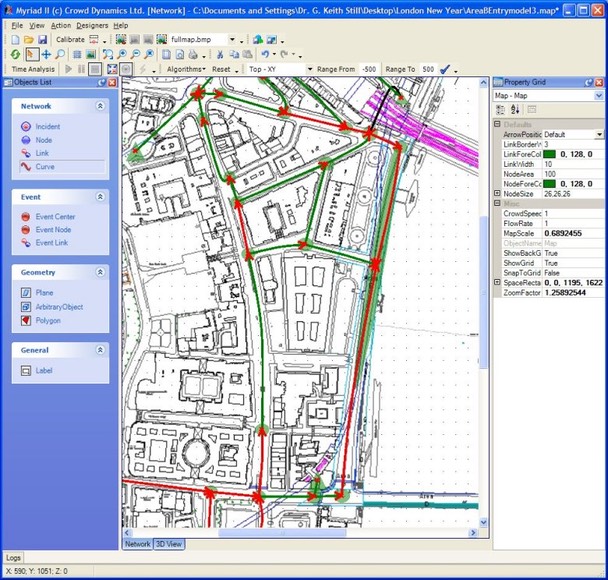“Keith Still’s workshops have focussed the minds of many people in realising just how easy it can be for disaster to occur, and equally how simple the solutions often are.” Eric Stuart, former Metropolitan Police Event Planner for Notting Hill Carnival and London New Year Events.
I ran a series of workshops (UK Cabinet Office Emergency Planning College), for the Police and Emergency Planners associated with the London New Year Event. Following these I was engaged to model the New Year Event 2006/7. The system - shown below - is a fill predictor designed and deployed for London New Year Events (LYNE). Since then I've run workshops for various elements of the site, planning and operations.

Left - the old modelling environment (Myriad II) where the user could create a network of the site and can experiment with filling the viewing areas for the London site.
This is a Network Analysis Tool used when the project requirements are for multiple flows in complex arrangements (typically streets, transport terminals etc). However, the algorithm in this network tool was linear and indicative only.
Modelling these kind of sites (at this scale) often throws up interesting issues. The slides below are an extract from the Crowd Science workshop in which I take delegates through the key stages of the problem and its solution.
From the network analysis we can address key questions such as flow rates and fill times. Also from these type of models we can determine a suitable crowd monitoring system.
We designed, developed and deployed a fill predictor (based on the modelling/analysis) to provide an estimate of how quickly the space was filling in real-time. Over the last 7 years we have run workshops on the information and management of crowds for this specific event. The system was designed to count from empty. In recent years the event spaces have been filling earlier and the arrival profile has significantly changed. The team who now operate the system should update the core algorithms accordingly.
Left - screen shot from the fill estimator (developed in 2007). Sample counts are made at key locations (1 minute counting number of people past this point - every 10 - 15 minutes) which provides a statistical analysis of the crowd flow. This is then processed (along with other counts at key locations) and analysed. The result is a prediction of when the space will be full. This allows management to prepare and be proactive to the impending fill time. Modelling and monitoring ingress (flow rates/arrival profile) facilitates better, safer, crowd management.
____________________________________________________________________________________________
During egress there were issues with congestion at key intersections. We modelled that part of the site and devised a solution to both simplify the crowd flow and provide better, safer crowd management for egress (see below - slides from the Crowd Science Workshop)
Above - the site (the London Eye is in the middle of the image)
Above - reverse infra red image of the crowds leaving the key viewing area)
Above - the main area of concern (and the outline of the key constraints - red lines)
Above - the key constraints (areas where the crowds move/flow). This is a simplification of the site so we can assess the key crowd flow directions
Above - by drawing the crowd flow paths (focal routes) we see that there are many line crossing, converging and counter flowing. At high density this indicates congested and confused spaces.
Where these lines cross, at high crowd density, we have high risk of congested trips, slips and falls.
Above - the station is a focal point. If we shut the station - where would the crowds go?
Also if we block off the bridge (dotted line) how would we fill and empty that space?
These are the key questions we can address in the simplified model.
____________________________________________________________________________________________
Bad Weather hampers New Year celebrations.
A fireworks spectacular heralded the start of 2007 in London but severe weather put a dampener on official New Year celebrations for thousands elsewhere. Scotland's biggest Hogmanay party in Edinburgh was among the events cancelled due to high winds and lashing rain. Celebrations were also scrapped in Glasgow, Belfast, Newcastle and Liverpool. The only event in Scotland was the Aberdeen Hogmanay Street Concert with Wet, Wet, Wet. The London events went ahead as planned, centred on the London Eye on the south bank of the Thames with hundreds of thousands turning out to watch the spectacular. With access to the south bank from Waterloo station closed off by police, thousands were forced to watch the fireworks from behind buildings and through tunnels and doorways. The weather remained dry with light winds. Mayor of London Ken Livingstone said: "London has once again kicked off the New Year in style. "My very best wishes for 2007 to all Londoners and everyone who came to the capital for the celebrations. "There was atrocious weather around the country last night and we wish to send our best wishes and goodwill to those who saw their New Year's Eve disrupted." A Scotland Yard spokesman said: "We estimate that in the region of 350,000 people came into central London to see in the New Year." At 11.59pm a digital clock was projected on to the Shell Building, signalling the 60-second countdown to midnight. After Big Ben had rung to mark midnight, a ten-minute pyrotechnic display began that included fireworks off the London Eye and from barges on the Thames.